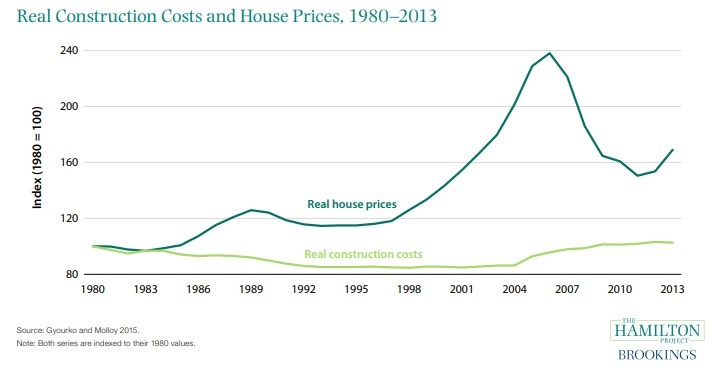◀ Republican reversal: The worst economic idea from what used to be the 'party of ideas'
The GOP can't be for economic opportunity and against pro-density housing reform
Item: For the past six years, through boom, bust and pandemic, California’s Legislature has ended each session with a blitz of new laws that aim to make housing more plentiful and affordable. … The laws received a decent amount of fanfare at each signing, signaling a turn in state policy and priorities. Until recently though, no one put much effort into enforcing them. That has started to change as Gov. Gavin Newsom has, for reasons practical and political, shifted toward an increasingly aggressive effort to enforce laws already on the books. This ranges from small-scale stings, like the state housing agency’s sending letters to local governments telling them that they are out of compliance with state housing regulations, to much larger efforts, like a first-of-its-kind investigation into San Francisco’s notoriously complex development process. … In some cases, the governor’s office is working with the attorney general to initiate lawsuits against localities that they believe are breaking the law. - The New York Times, 09/01/2022
The notion of the “American Dream” isn’t just political boilerplate, or at least it shouldn’t be. The phrase means something. And what I think it means, broadly, is Americans having as much opportunity as possible to create a life for themselves that’s financially better than the one their parents had — what economists call “upward mobility.” Or to put it another way: If you’re doing better as an adult than the circumstances you experienced as a kid, then you’ve been upwardly mobile. While money certainly isn’t everything, few of us wish for our children growing up to have fewer economic resources than we had growing up. (By the way, US upward mobility remains strong.)
In many cases, pursuing the American Dream means moving to where the better jobs are. Location, location, location isn’t important just for the real estate market. It’s important for upward mobility. Always has been. I’ve previously highlighted the important findings about upward mobility found in Streets of Gold: America’s Untold Story of Immigrant Success by economists Ran Abramitzky (Stanford University) and Leah Boustan (Princeton University). Three key takeaways:
Children of immigrants from nearly every country are more upwardly mobile than the children of US-born residents raised in families with a similar income level.
While children of immigrants outearn other children nationally, they don’t earn more than other children who grew up in the same area. This pattern suggests the primary financial difference between immigrant families and US-born families is where they choose to live.
The economists conclude it is “very likely that US-born families would have achieved the same success had they moved to such high-opportunity places themselves.”
The malfunctioning mobility mechanism
That final point from Abramitzky and Boustan gets to the fundamental importance of housing reform in making the American Dream accessible to more Americans. The mechanism of geographic mobility driving upward mobility needs major repair. As economist Daniel Shoag of the Harvard Kennedy School and Case Western Reserve University wrote in 2019: “Historically, Americans have moved to the parts of the country that offered the highest wages and most economic opportunity. However, this dynamic has faltered in recent decades, as land-use restrictions have limited housing availability in America’s booming local economies. These regulatory constraints have shut millions of Americans out of the country’s most-productive labor markets.”

The phony war on the suburbs
Which brings us to the modern Republican Party. Of all the bad policy ideas coming out of the Trump-era GOP and the nationalist-populist variant of American conservatism — trade protectionism, immigration rejection, ignoring entitlement reform, embracing industrial policy — its stand on housing reform is among the most disappointing. Heck, maybe it’s the most disappointing given the issue’s importance, the power of the economic arguments in favor, and the potential for bipartisanship. But once something becomes a culture war “wedge” issue, none of that other stuff seems to matter.
Case in point: Back in January 2020, the Department of Housing and Urban Development proposed a new rule with the goal of increasing housing choice by “ensuring an adequate supply of affordable housing.” But by the summer of 2020, with election season in full swing, the Trump administration reversed course. In a Wall Street Journal op-ed, President Trump and HUD Secretary Ben Carson described density-centric housing reform as an attack on America’s suburbs: “… a relentless push for more high-density housing in single-family residential neighborhoods, has become the mainstream goal of the left.” This is a claim that echoes what populist right-wing pundits such as Tucker Carlson had already been saying and remains a populist attack line against the Biden administration. As AEI economist Stan Veuger correctly stated back in 2020 in a blog post on the switcheroo:
Why have Trump and Carson walked away from their own proposal? It strikes me as a transparent gambit to win over suburban voters by presenting zoning reform and affordable housing as a threat. It is sad to see the GOP walk away from pro-growth housing policies that could constitute an economic boon in a time of double-digit unemployment and tremendous hardship concentrated among low-income households.

Cheaper coastal tech hubs vs. more Midwest tech hubs
The transformation of housing reform into a culture war issue is reason to despair about the viability of a pro-progress, Up Wing agenda that crosses both parties. I mean, Republicans aren’t even trying to make a substantive case against density. What might one look like? Hints can be found in the new working paper “Place-Based Productivity and Costs in Science” by Jonathan Gruber, Simon Johnson, and Enrico Moretti (GJM). It’s an interesting group of economists. Gruber and Johnson have previously proposed an ambitious and expensive plan to create a network of new technology hubs across America, an idea reflected in recent R&D legislation in Washington. (Back in 2019, I podcast chatted with Gruber about his book, coauthored with Johnson, Jump-Starting America: How Breakthrough Science Can Revive Economic Growth and the American Dream.) Moretti has been instrumental in identifying the large aggregate economic costs of restrictive zoning policies that keep housing prices high and limit the inflow of population into high-productivity cities and regions. (I also chatted with Moretti in 2019.)
In the paper, GJM find that for “areas that currently have a small cluster [of scientists] the productivity gains of adding an additional scientist are much larger than the corresponding cost increases,” but for the largest innovation clusters — including the San Francisco Bay Area, Boston, and New York City — “the productivity gains of adding an additional scientist are still larger than the corresponding cost increases, but not by much.” This might argue for government funding that promotes innovation hubs outside the coasts. GJM make three points about the value of placed-based technology policy:
Everyone isn’t going to move to the Bay Area. “In a world of imperfect mobility and imperfect information on underlying needs, place has a role in redistribution. Redistributing by place allows a tool for targeting needy individuals that are missed by other redistributive systems.”
What about a mega-quake, tsunami, or asteroid strike? “A second argument in favor of these policies is robustness to geographic shocks — particularly in a nation as large as the United States. Catastrophes, man-made or natural, would have an outsized effect on the US if they happen to occur in the very few, most agglomerated locations. A broader portfolio of technology centers provides a form of insurance against geographically focused shocks.”
Politics matters. “Gruber and Johnson (2019) point out that one of the reasons for the weak public support in the U.S. for public investment in R&D is the geographical concentration of such investment. In a nation where voting is related to population and geography, not income or productivity, investments that concentrate their benefits in small geographic (even if densely populated) places may suffer from a lack of political support. Gruber and Johnson argue that even if there is some efficiency loss from redistributing R&D, the rate of return to more R&D is high enough that more geographic dispersion may lead to more overall efficiency by raising the level of support for public science spending.”
I don’t think those reasons exclude doing zoning and land-use regulation reform, but if you were a GOPer against those things, you could theoretically substitute the Gruber and Johnson Jump Start plan in place of housing reform — a“rise of the rest” kind of thing via tech hubs across the Rust Belt or some such.
That said, Democrats continue to embrace and push the housing reform issue. And not just center-left policy journalists who have made housing affordability and density a key part of their embryonic “supply-side progressivism” agenda. Back in May, President Biden announced a “Housing Supply Action Plan,” that would “[r]eward jurisdictions that have reformed zoning and land-use policies with higher scores in certain federal grant processes, for the first time at scale.” It’s an approach to nudging reform on the local level that echoes the Obama administration’s “Race to the Top” program to encourage education reform.
Opening the window on housing reform
And what is happening on the local level? Well, some good news in California, which has become ground-zero for the housing affordability issue. Last year, Gov. Gavin Newsom signed bipartisan legislation that chipped away at restrictive zoning rules, including allowing two homes or a duplex on lots that had for decades been reserved exclusively for single-family homes. And as the news item at the top of this newsletter informs, Newsom seems intent on making sure a whole slew of reforms actually get implemented.
Now, there’s been some talk about Newsom running for president. Imagine if the Democratic nominee were a vigorous proponent of housing reform ... and so was the Republican one! It could happen. Not everyone in the GOP seems to be anti-reform, at least not yet. Down in Florida, for instance, Gov. Ron DeSantis signed legislation in 2021 to reduce bureaucratic delay in the permitting process.
It requires local jurisdictions to post online not only their permitting processes but also the status of permit applications. The transparency takes a good amount of mystery out of what can be an inscrutable branch of bureaucracy. More important, the reforms also created a system that strongly incentivizes cities and counties to approve new home permits in a timely way. When a builder or property owner submits an application to build a new home, cities and counties have 30 business days to process it or request corrections.
It’s also worth noting that whatever national Republican pols and pundits are saying, Republicans on the ground may feel differently. Indeed, there were Republican legislators who supported California’s housing reforms (just as some progressive Democrats opposed them). Republicans used to embrace state-level policymaking. “Laboratories of democracy” and all that. Maybe that bit of old-fashioned GOP thinking may yet make a comeback.
Micro Reads
▶ European Industrial Shutdowns in the Pipeline - Goldman Sachs | Following the collapse in Russian gas exports to continental Europe, wholesale and consumer gas prices have surged over the past few months, even after the correction of the past week. …Despite these shocks, industrial production cuts appear somewhat limited so far. … The outlook for European industry looks significantly more concerning. More timely July IP data for gas-intensive German companies has fallen further, hinting at steeper declines in upcoming data releases. Additionally, August surveys of gas-intensive industries indicate falling output and a collapse in German business expectations. Finally, the most common reason our equity analysts cite for the resilience of IP thus far—the ability to raise prices on resilient demand—is likely to wear off as rising inflation further depresses real consumer incomes.
▶ NASA Opts to Fix Megarocket Hydrogen Leak at the Launch Pad - George Dvorsky, Gizmodo | NASA is preparing to replace a faulty seal linked to a hydrogen leak that resulted in the second scrubbed launch attempt of SLS on Saturday. The repairs will happen at the launch pad, which is ideal from a testing perspective, but NASA still needs to cart the jumbo rocket back to the assembly building to meet safety requirements. … A third launch attempt in late September or early October remains a distant possibility. The next period opens on September 19 and closes on October 4, with no opportunities to launch on September 29 and 30. For this to work, however, NASA would have to complete its latest fix, run tests, cart SLS back to the VAB for recertification (which involves a very short confidence test), and then cart it back to the launch pad. It’s possible, but ground teams will have to haul ass to make this happen. … There’s still plenty of time for SLS to launch in 2022, but it all depends on how quickly engineers can get a handle on this complex system. SLS is the most powerful rocket that NASA has ever built and is a key component of the space agency’s Artemis program, which seeks a sustained and prolonged human presence at and around the Moon.
▶ How nasal-spray vaccines could change the pandemic - Emily Waltz, Nature | Are sprays the future of COVID-19 vaccines? That’s the hope of dozens of research groups and companies working on new kinds of inoculation. Rather than relying on injections, these use sprays or drops administered through the nose or mouth that aim to improve protection against the virus SARS-CoV-2. This week, an inhaled version of a COVID-19 vaccine, produced by the Chinese company CanSino Biologics in Tianjin, was approved for use as a booster dose in China. It’s one of more than 100 oral or nasal vaccines in development around the world. … A few mucosal vaccines are already approved for other diseases, including a sprayable vaccine against influenza. Evidence in animals supports the idea that sterilizing immunity can be induced against COVID-19, although data from humans are scant.
▶ Longtermism is influencing billionaire philanthropy and shaping politics. Should it guide the future of humanity? - Sigal Samuel, Vox | And, hey, avoiding extinction sounds like a very reasonable goal! But this pivot generated controversial questions: How many resources should we devote to “longtermist” versus “near-termist” goals? Is the future a key moral priority or is it the key moral priority? Is trying to help future people — the hundreds of billions who could live — more important than definitely helping the smaller number of people who are suffering right now? This is why it’s useful to think of longtermism as a train: We can come up with different answers to these questions, and decide to get off the train at different stations. Some people ride it up to a certain point — say, acknowledging that the future is a key and often underappreciated moral priority — but they step off the train before getting to the point of asserting that concern for the future trumps every other moral concern. Other people go farther, and things get ... weird.
▶ Separating quantum hype from quantum reality - Simon Benjamin, FT Alphaville | And not every business will benefit from quantum computers, at least at first. The earliest impact will be in areas related to materials science (including energy materials), chemistry, or optimisation (possibly stretching to logistics/transport). Even in these sectors, businesses need only get involved if they want to be part of the enabling technology rather than a user. Others can relax despite calls to become ‘quantum ready’ — they won’t miss the quantum bus, because the bus is still being built. But to suggest that there will never be high-value applications, and that quantum computers will never repay their R&D investment, is wrong.





